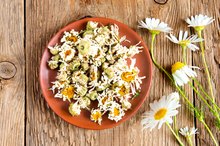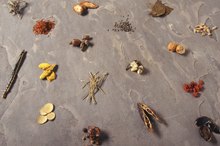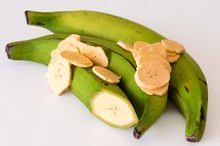Dopamine Lowering Herbs
Dopamine is a neurotransmitter that carries messages about cognition, pleasure, pain, movement, learning and sleep between nerve cells. People with psychotic disorders like schizophrenia and manic depression have too much dopamine in their brains. Antipsychotic drugs lower dopamine levels by blocking the dopamine receptors in the brain, but they can have unpleasant side effects. Herbs can lower dopamine levels in a variety of ways. Do not combine these herbs with antipsychotic medication or with drugs that stimulate dopamine production.
Turkey corn
Turkey corn (Corydalis cava), a member of the poppy family, is a small plant with bright, drooping flowers ranging from white to reddish purple. It was used traditionally in teas and tinctures to treat syphilis and skin diseases. The root contains the alkaloid bulbocapnine, which affects the central nervous system and can be toxic to animals. A report published in “Neuroscience Letters” found that bulbocapnine inhibits dopamine synthesis in the brain by blocking the enzyme tyrosine hydroxylase, which is needed to convert L-tyrosine into levodopa, the precursor to dopamine and other neurotransmitters.
- Turkey corn (Corydalis cava), a member of the poppy family, is a small plant with bright, drooping flowers ranging from white to reddish purple.
- The root contains the alkaloid bulbocapnine, which affects the central nervous system and can be toxic to animals.
Graviola
Natural Alternatives to Larazapam
Learn More
Graviola (Annona muricata) is a small evergreen tree that produces a fruit called graviola or guanábana. The plant is native to tropical areas in North and South America. The fruit and leaf extracts contain high concentrations of a chemical called annonacin, which destroys the nerve cells involved in dopamine activity. A report in the 2006 issue of the “Journal of Neural Transmission” found that annonacin can cross the blood-brain barrier and act like other compounds involved in Parkinson’s disease, which is characterized by a low level of dopamine in the brain. Do not use graviola if you are pregnant, have low blood pressure or are taking blood pressure medication.
- Graviola (Annona muricata) is a small evergreen tree that produces a fruit called graviola or guanábana.
- A report in the 2006 issue of the “Journal of Neural Transmission” found that annonacin can cross the blood-brain barrier and act like other compounds involved in Parkinson’s disease, which is characterized by a low level of dopamine in the brain.
Magnolia-bark
Magnolia-bark (Magnolia officinalis) is a bitter herb used in traditional Chinese medicine for digestive disorders and to treat anxiety and asthma. It contains anonaine, an alkaloid that blocks dopamine synthesis in the body. A report in the 2009 issue of the “Journal of Ethnopharmacology” found that magnolia-bark had an antagonistic effect on the dopamine transporter and one of the dopamine receptors.
Moonseed
Common Herbs With MAO Inhibitor Activity
Learn More
Moonseed (Menispermum canadense), also known as yellow parilla, is a climbing vine with yellow roots and clusters of dark purple berries. The fruits are poisonous, but Native American groups in North America and Canada used the root as a tonic and laxative, and to treat rheumatism. The moonseed root contains the dopamine-lowering alkaloid dauricine, a calcium channel blocker. According to the Neuroscience Education Project at Williams College, when calcium channels are blocked, dopamine release is inhibited.
- Moonseed (Menispermum canadense), also known as yellow parilla, is a climbing vine with yellow roots and clusters of dark purple berries.
- The fruits are poisonous, but Native American groups in North America and Canada used the root as a tonic and laxative, and to treat rheumatism.
Related Articles
References
- “Neuroscience Letters”; Inhibitory effects of bulbocapnine on dopamine biosynthesis in PC12 cells; Shin JS, Kim KT, Lee MK; March 1998
- “Journal of Neural Transmission”; Is atypical parkinsonism in the Caribbean caused by the consumption of Annonacae? Lannuzel A, Höglinger GU, Champy P, Michel PP, Hirsch EC, Ruberg M; 2006
- “Journal of Ethnopharmacology”; Interactions of Magnolia and Ziziphus extracts with selected central nervous system receptors; Koetter U, Barrett M, Lacher S, Abdelrahman A, Dolnick D; July 2009
- Carlsson A, Carlsson ML. A dopaminergic deficit hypothesis of schizophrenia: the path to discovery. Dialogues Clin Neurosci. 2006;8(1):137-42.
Writer Bio
Janet Contursi has been a writer and editor for more than 23 years. She has written for professional journals and newspapers, and has experience editing educational, cultural, and business articles and books. Her clients include Gale Publishers, Anaxos, Vielife and Twin Cities Wellness. Contursi earned her Ph.D. at the University of Minnesota, where she studied cultural anthropology, South Asian languages and culture, and art history.









